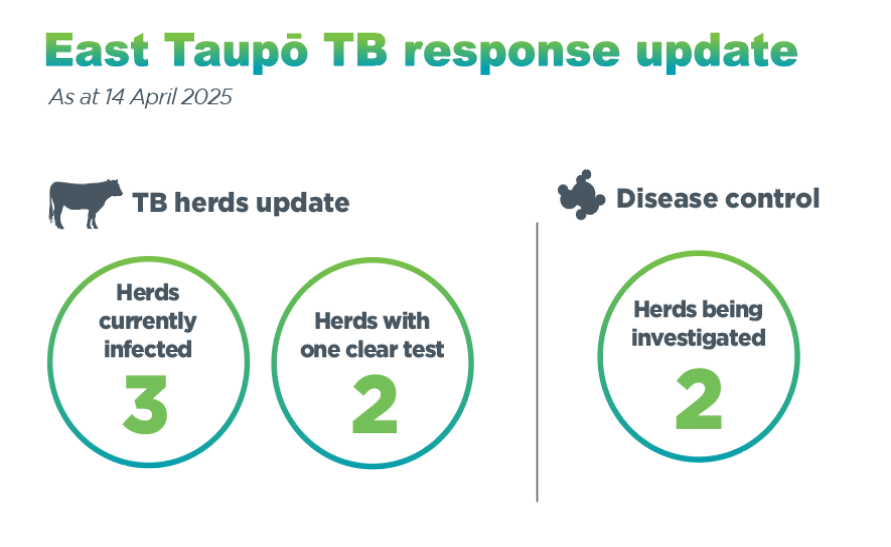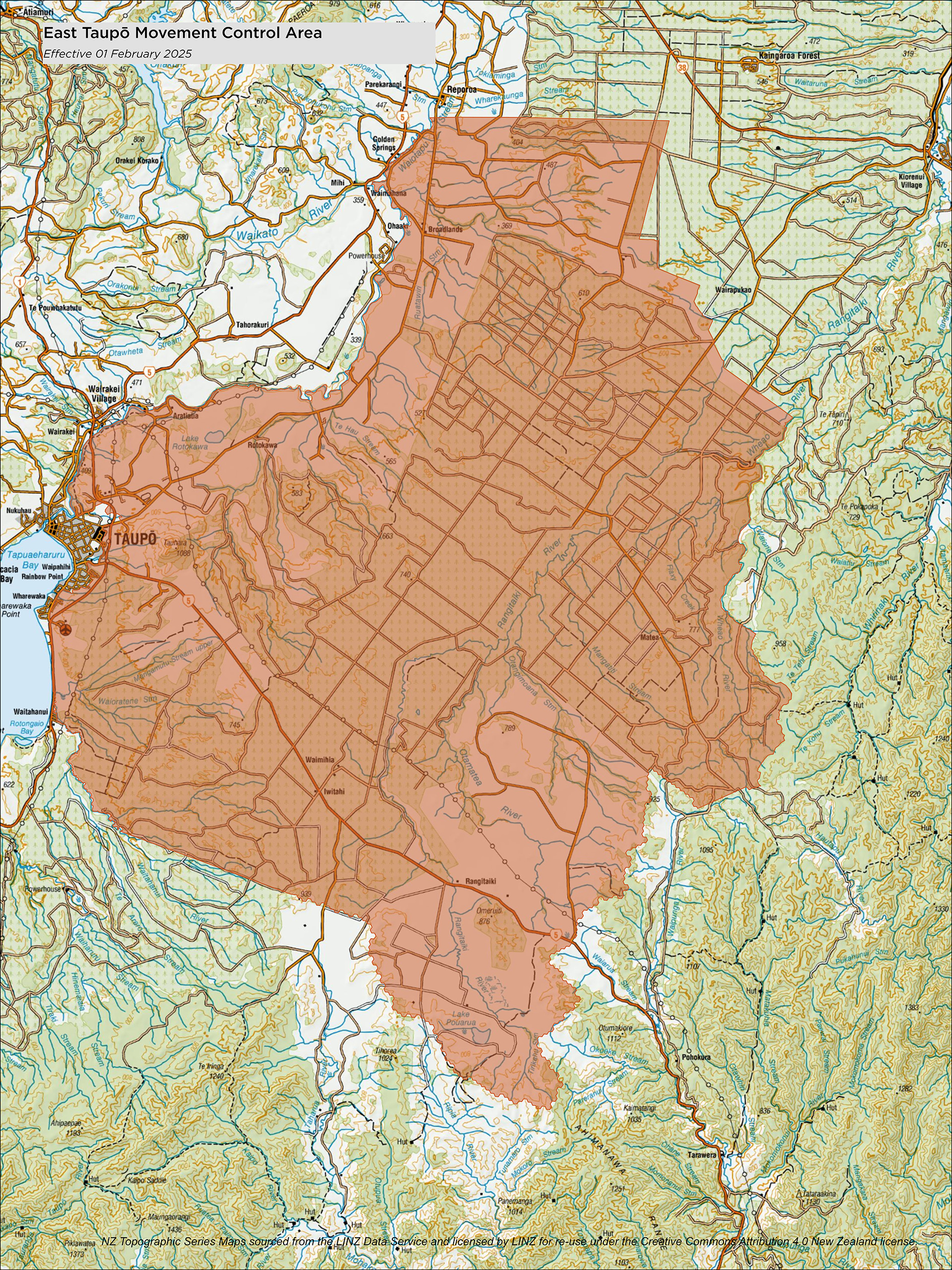East Taupō TB response
We have 3 herds infected with TB in the East Taupō area. To prevent further spread we've implemented movement control for these and nearby herds. We're implementing pest control operations and a TB testing plan.
What we know about TB in East Taupō
While the East Taupō district has been considered free of TB for years, an infected herd was detected within 40km of an area where we know disease is present in wildlife. It was concerning that the farming operation's livestock movements showed no obvious links to other (TB-infected) herds outside of the region.
By mid-November 2023 we had linked the strain from East Taupō’s first infected cow to more recent Hawke's Bay infections. We determined this using whole genome sequencing.
In July 2024, we found evidence of TB in local wildlife, supporting our early suspicions that the disease pathway was due to contact with infected possums.
Land ownership or interest have complexities, so our response has involved many meetings, hui, door knocks and phone calls to identify local stakeholders, businesses or people who could be impacted by our work. Early and positive collaboration gives us confidence of returning East Taupō to a TB-free status.

Diagnosing TB in cattle and deer takes time and is not a simple process and, in most cases, can take 6 to 10 weeks to diagnose. This month:
- we have 3 herds with a TB-infected status in the district
- we’re investigating 2 other herds for TB — further testing will determine whether or not the disease is present.
To date:
- 89 pig heads have been collected
- 19,089 possum traps have been deployed
- 39,789 hectares are being controlled, and 20,088 hectares completed.
Responding to TB infection in herds

This map shows the area where we have restricted livestock movement (from 1 Feb 2025), it’s an effective way to address the risk of TB spreading outside of the region. Other disease management activities underway here, and in the wider response area, include:
- on-farm TB testing
- wildlife surveys
- pest control
- supporting existing conservation efforts.
More information on Movement Control Areas can be found on the link below.
Our response so far
- OSPRI has worked closely with the impacted farms, supporting the people and their herds' recovery.
- Cattle on each of these farms are subject to movement control, to prevent the risk of disease spread, and then further TB testing. Where we felt there is a heightened risk of wildlife infection, nearby herds were also placed under movement control.
- We immediately started trapping work to protect the first infected farm and neighbours. Since January over 1400 possums have been caught, and bait stations were put in place after this initial trapping.
- In the wider area extra testing was carried out over January and February 2024, and at that time no further disease was found.
- Since late 2023, we also started working with local pig hunters to gather pigs heads. Pigs are a very useful tool to look for TB in the wildlife population, and have had 89 pig heads handed in.
- With continued routine testing of livestock under movement control, between May and June, three more TB infected herds were discovered. Declaring an animal TB positive is a step-by-step process, starting with skin tests at the farm and ending with a post-mortem typically over a month later.
- In June, we changed the on-farm TB testing policy for other farms in the immediate area and advanced their test due date. These changes increased our surveillance in this new special testing area.
- During July 2024, our lab confirmed TB within a wild pig removed from an affected property, supporting a conclusion that their herd breakdown occurred due to contact with infected possums.
- By August 2024, completed possum control had increased to 17,000 hectares in the immediate area.
- By December 2024, a further 7664 hectares of work was underway, and early in 2025 possum control will commence on another 17,111 hectares.
- From 1 February 2025 the central North Island movement control area extends to include the area east of Lake Taupo.
What we're doing next
We will keep working with pig hunters as we look for the disease in a wider area.
Wider landscape possum control involves working with the landowners, iwi trusts, hapū, lessees, conservation groups, pest control operators and forestry managers across approximately 89,000 hectares.
Pest control operators may have already been in touch about work on you block or farm or near you.
What this means for farmers and lifestyle block owners
You can help by presenting your animals for additional TB testing, if asked. When investigating a herd infection, we often ask this of other farmers in the district.
Ensure you:
- tag cattle and deer
- record animal movements in NAIT
- keep your NAIT records up to date.
Having access to accurate data is crucial when dealing with an infectious disease or biosecurity threat.
Support available
We know having TB-infected herds in the area can be stressful for farmers, neighbouring families and communities. We're available to help, as is The Rural Support Trust.
How many infected herds are there?
There are 3 infected herds in the area.
Where has the infection come from?
With capture of a wild pig with TB on local farmland, and all other disease pathways investigated, we have concluded infection was through wildlife. Pigs are good indicators of TB in surrounding habitat because they scavenge widely. They can’t maintain TB in their own population, so if they're infected it means it’s from another species — and the main carrier and spreader of TB in New Zealand is possums.
Will this affect my herd's TB status?
Your herd's TB status is not affected by these TB cases.
Do I need to get my herd tested?
Possibly. If you're in the new special testing area, your local tester will contact you to present your animals for testing. This test policy requires annual TB tests and applies to all animals over 6 months old. Otherwise, if you are unsure of your next test date, contact our Support Centre on 0800 482 463.
Are herds under movement control?
Yes. We have placed some herds in the area under movement control to manage the risk of TB spreading through animal movement. We’ve done this where we think wildlife infection is possible. We have notified affected farms. If we extend movement control in the district, we'll advise you.
My stock are due to go to the works soon. Do I test my stock first?
No — unless you're specifically requested to by one of our veterinarians.
What is NAIT?
NAIT is an online tool used to provide fast and accurate tracing of NAIT animals. Ensuring your NAIT records are correct, and current, is critical in helping us eradicate TB. It helps us determine the most likely source of TB infection, and enables us to protect other herds from infection.
To log on or register with NAIT, use the NAIT Login button, top right of this page.
How do I get help with my NAIT account?
If you need help with fixing NAIT records, call our Support Centre on 0800 482 463.

